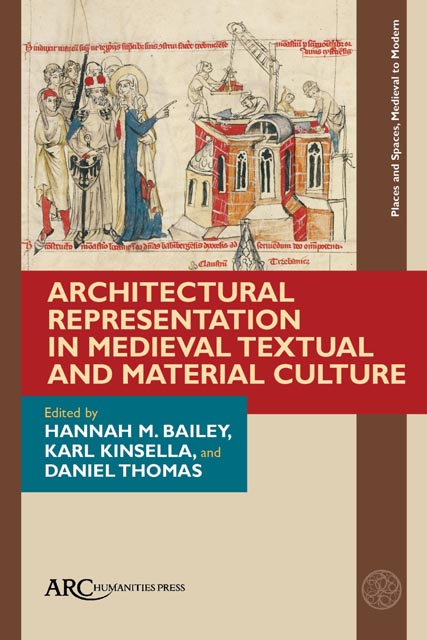Book contents
- Frontmatter
- Contents
- List of Illustrations
- Acknowledgements
- Introduction: Architectural Representation in Medieval Textual and Material Culture
- Chapter 1 Designing the Regensburg Spire and Harburg Tabernacle: The Geometries of Two Great German Gothic Drawings
- Chapter 2 Wilfrid’s Restoration of the Church at York and the Permanence of Sacred Buildings in Post-Conversion Northumbria
- Chapter 3 Heaven-Roofs and Holy Altars: Envisioning a Seventh-Century English Church in Aldhelm’s Carmina Ecclesiastica 3
- Chapter 4 “Beaten Down and Built Anew”: Saint Erkenwald and Old St. Paul’s
- Chapter 5 Castle Viewscapes in Literature and Landscapes
- Chapter 6 Architectural Alignment in Early Medieval English Settlements: Zoning, Meaning, and Function
- Chapter 7 Underneath the Arches: Peter of Eboli and the Orderly Architecture of Norman Sicily
- Chapter 8 Reading the Saint’s Church: A Northern Perspective
- Select Bibliography
- Index
Chapter 2 - Wilfrid’s Restoration of the Church at York and the Permanence of Sacred Buildings in Post-Conversion Northumbria
Published online by Cambridge University Press: 16 November 2023
- Frontmatter
- Contents
- List of Illustrations
- Acknowledgements
- Introduction: Architectural Representation in Medieval Textual and Material Culture
- Chapter 1 Designing the Regensburg Spire and Harburg Tabernacle: The Geometries of Two Great German Gothic Drawings
- Chapter 2 Wilfrid’s Restoration of the Church at York and the Permanence of Sacred Buildings in Post-Conversion Northumbria
- Chapter 3 Heaven-Roofs and Holy Altars: Envisioning a Seventh-Century English Church in Aldhelm’s Carmina Ecclesiastica 3
- Chapter 4 “Beaten Down and Built Anew”: Saint Erkenwald and Old St. Paul’s
- Chapter 5 Castle Viewscapes in Literature and Landscapes
- Chapter 6 Architectural Alignment in Early Medieval English Settlements: Zoning, Meaning, and Function
- Chapter 7 Underneath the Arches: Peter of Eboli and the Orderly Architecture of Norman Sicily
- Chapter 8 Reading the Saint’s Church: A Northern Perspective
- Select Bibliography
- Index
Summary
A twenty-first-century tourist in search of the architecture of Northumbria's “Golden Age” will be struck by two things. First, how little of it there is. The grand ruins at Whitby and Lindisfarne are of later medieval establishments, leaving our tourist with little more than small, though evocative, elements in the existing churches at Monkwearmouth and Jarrow, the dark crypts of Ripon and Hexham (assuming someone is available to open them), or the completely mysterious magnificence of the little church at Escomb. The second thing our tourist will probably notice is that these churches require constant streams of money to be maintained; the success of St. Paul's church at Jarrow in hosting an annual lecture, sales of the printed text going to the church restoration funds, has been mimicked by an increasing number of other ecclesiastical sites for the simple reason that such revenue is important. Anyone who has ever bought a house in England will have had to take out Chancel Liability Insurance and will know about the potentially ruinous cost of medieval church upkeep. Our tourist will, therefore, know that most early Northumbrian churches were anything but permanent and that protecting the permanence of those few that have survived is a constant battle. What they might not know is that these are not modern issues—early Northumbrian Christians also grappled with the problems and costs of ensuring the permanence of sacred buildings. This chapter shows how one episode from Stephen of Ripon's account of St. Wilfrid sheds light on just these issues; one hagiographer's brief representation of architecture opens a window for us on to the stresses and strains of a fast-changing world.
The Cleansing of the Church of York
Wilfrid was one of the early Northumbrian church's most controversial leaders. After his success at the Synod of Whitby in 664 arguing against the traditions of the Columban/Ionan community who ruled the Northumbrian see from Lindisfarne, Wilfrid became the kingdom's bishop. His subsequent career was marked by numerous attempts to withdraw, divide, and move his bishopric, as well as by Wilfrid's own energetic efforts to resist. Within a few years of his death in 710, Stephen, a member of Wilfrid's former community at Ripon, had written a Life of Wilfrid, notable amongst other features for its interest in architecture.
- Type
- Chapter
- Information
- Publisher: Amsterdam University PressPrint publication year: 2023

